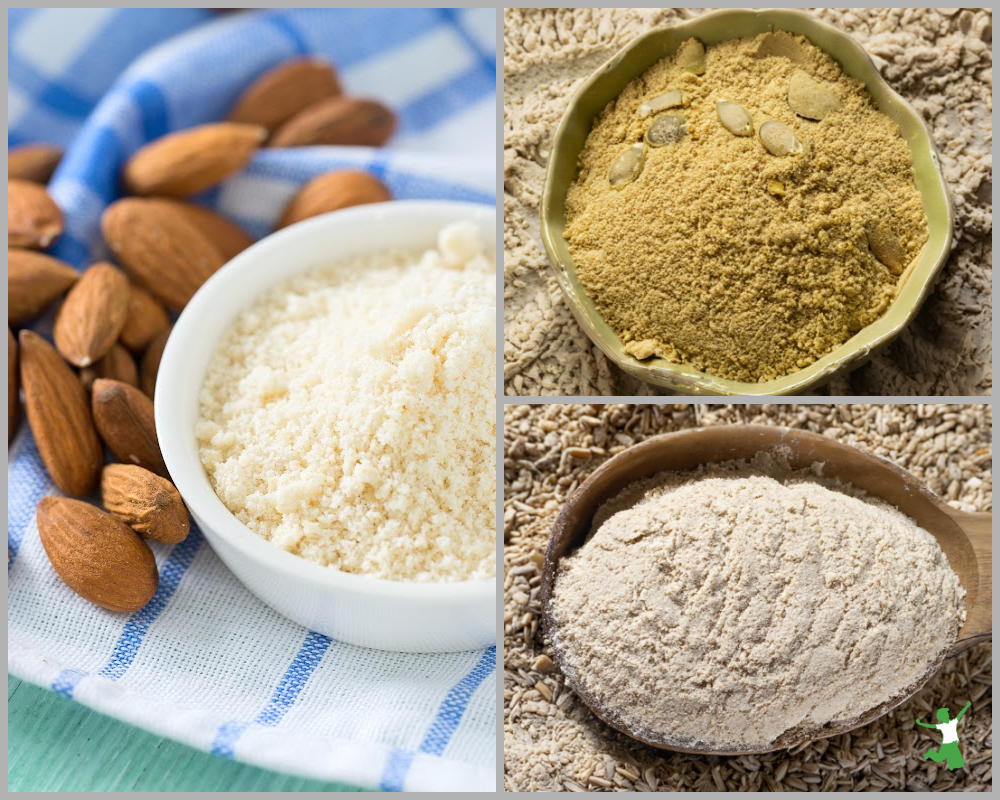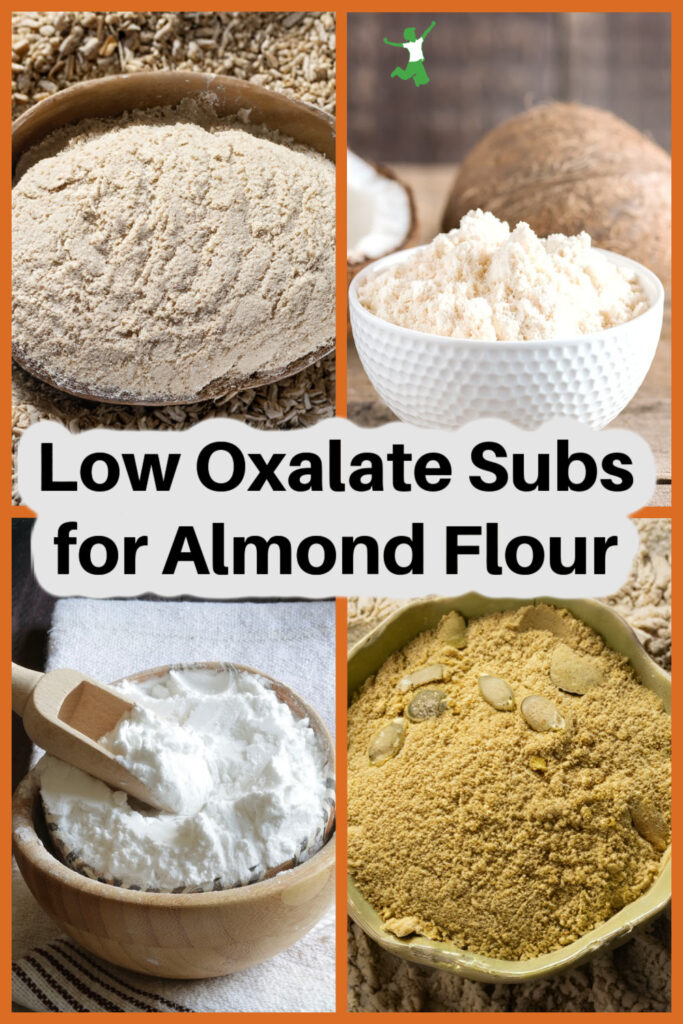Low oxalate alternatives to almond flour and other types of nut meal for keto or grain-free baking and cooking needs.

My grain-free blueberry pecan cobbler food feature in the weekly newsletter elicited a number of questions for a low oxalate alternative to the nut flour portion of the recipe.
Why Do Some People Avoid High Oxalate Foods?
More people than ever are following a low oxalate diet due to issues with oxalate crystal build-up in bodily tissues.
Chronic problems with kidney stones are a hallmark symptom.
About 10% of the population is genetically predisposed to damage from a diet high in oxalates.
In addition, those with excessive fungus (candida) in the gut are at risk from high oxalate foods as well.
This is because certain beneficial strains of gut flora, specifically species from the genus Oxalobacter, break down oxalates for us!
These anti-oxalate microbial strains are decimated by antibiotics and potentially dozens of other pharmaceuticals.
When these strains are missing in an imbalanced gut, oxalates in food have the potential to cause symptoms.
Keto Diets and Excessive Oxalates
To add insult to injury, many people who are sensitive to oxalates are also eating grain-free with low to no starch in an attempt to lose weight and/or heal the gut.
For example, the GAPS diet, Candida diet, and Specific Carbohydrate Diet all disallow grains and starch as part of the healing protocol.
Many keto dieters find this out the hard way.
They cut out the grain-based and starch carbs and substitute with higher oxalate foods like almond flour only to suffer a kidney stone attack or more serious symptoms like vulvodynia within a few months.
With almond flour perhaps the most popular grain-free option for cooking and baking, I thought I would share a few words on what the best alternatives might be if you are oxalate sensitive and need to reduce exposure.
Low Oxalate Nut Flour?
Unfortunately, the term “low oxalate nuts” is a bit of an oxymoron.
While there are nuts that are lower in oxalates than others, there really aren’t any truly “low oxalate nuts” that I’ve come across.
For example, pecans, walnuts, and macadamia nuts are perhaps the lowest in oxalates coming in at 10 mg, 8 mg, and 12 mg per ounce, respectively.
To be considered “low oxalate”, a food really needs to be less than 10 mg per serving.
Thus, even nuts that contain the least amount of oxalates are right on the borderline of being too high.
Starch Flours
When it comes to avoiding high oxalate nut flours, particularly almond which is highest in oxalates, potato starch or flour is the best alternative.
However, avoid cassava (tapioca) flour and arrowroot, which are both on the higher end for oxalates.
Since potato flour is very starchy, it would not be an acceptable choice for those on a low-carb diet for weight loss purposes or a gut-healing diet like GAPS.
However, for those who are able to tolerate a starch-based alternative to almond flour, potato flour is the best low-oxalate option to consider.
Fruit Flours
Another good alternative to nut flour like almond is coconut, considered a fruit flour because it comes from a drupe.
However, watch out for others like green banana flour and plantain, which are significantly higher in oxalate.
The downside of coconut flour is that it cannot be substituted 1:1 in recipes calling for almond flour.
Only small amounts of coconut flour are suitable in a recipe.
Thus, another flour will typically need to be blended with coconut flour to achieve the right texture. Another option is to use one of the flours below on its own when subbing out the almond flour.
My favorite options to use for this purpose are discussed next.
Seed Flours
By far, my best recommendation for low-oxalate alternatives to almond flour is seed flour.
Specifically, sunflower seed flour is my personal favorite followed by pumpkin seed meal.
Avoid flaxseed meal or flour, however, which is sadly a very popular low-oxalate dietary choice.
This is because flax is very estrogenic, second only to soy. Regular consumption of flax can trigger precancerous breasts among other hormonal issues if eaten frequently.
I personally never include anything flax on the menu. Our world is so polluted with pseudo-estrogens as it is.
Even if you live very clean and eat high-quality food, you are likely getting exposed to their effects. Hence, in my opinion, there is only a downside to adding flax to your diet.
Sunflower seed flour is excellent because you can substitute it 1:1 for almond flour in your recipes.
Be aware that you will need to make it yourself as commercial versions are likely stale and/or rancid.
The good news is that it is quite simple to make.
I recommend buying sprouted sunflower seeds (this is the brand I use) and milling into fresh flour in a coffee grinder.
Alternatively, you can soak hulled sunflower seeds overnight, drain and dry them in a warm oven (or dehydrator), and then mill into flour. This method is a bit more time-consuming, but less expensive.
Baking Tips
Grain mills don’t work that well for milling seed flours due to the oiliness. Thus, it is a good idea to invest in an inexpensive coffee grinder for this task.
If you are cooking for a large household, make large batches and then freeze for quick use later!
Frozen seed flour can be used in recipes straight right out of the freezer with no thawing time necessary.
Conclusion
While higher oxalate foods are not unhealthy and were routinely included in traditional diets from around the world, in our modern era, some people need to avoid them at least temporarily.
This is due to a need for rebalancing the gut to a more diverse and favorable microbial balance.
During this time, grains are best avoided along with high oxalate almond and other nut flours.
The most practical 1:1 substitution in recipes that is also grain and starch free is sunflower seed flour followed by pumpkin seed meal (a bit harder to mill into fine flour).
Potato starch or flour is also an option for those able to tolerate starch and not otherwise on a gut healing protocol.
In addition, coconut flour is an option, but only small amounts work well in baking due to textural issues.
For an optimal digestive and nutritional experience, I recommend milling sunflower or pumpkin seed flour from sprouted or soaked seeds.

References
(1) Low Oxalate Nuts and Seeds
(2) Best Substitutes for Almond Flour
(3) Oxalates on a Gluten-free Diet








Recent research shows that both bananas and plantains are low oxalates. In addition, the Food Intolerance App and the Cronometer App, which accesses multiple food science databases, show that they are low in oxalate. Thoughts on updating this quote in your blog? In addition, multiple research papers are now researching the impact of cooking and oxalates. For instance, boiling spinach reduces oxalates 30-83%.
While ripe bananas and plantains are moderately low in oxalates, in flour form (unripe green banana flour) they are not (22.56 oxalates per 1 Tbsp). https://www.facebook.com/groups/TryingLowOxalates/
I am wondering if Oat flour would be a good substitute?
Oats are extremely high in phytates and oats are also a grain, so oat flour would not considered a grain-free, low antinutrient option.
Sarah, thank you for this great information and speading the word about oxalates! I recently discovered that my diet was high in oxalates and now that I am cutting them out of my diet, I have been feeling much better! I did read Sally K Norton’s book called “Toxic Superfoods” and she mentions that potato starch is low in oxalates, however potato flour is high oxalates.
I always look forward to your well thought out articles!!
Interesting! I wonder why she identifies potato flour as higher when the difference between the two is mainly processing.
Most of the oxalates in potato are the skin, which is not used to make the flour. Perhaps some brands do use the skin? Hmmmm.
What is your opinion on using Tigernut flour as an alternative to nut-flours?
Here’s some information that is worth considering. https://www.thehealthyhomeeconomist.com/tiger-nuts-benefits-concerns/
Thank you for this article. I am male. I have flax everyday. Should I not be consuming organic flax on my breakfast oatmeal?
I do not feel that flax is good for either men or women. Far too estrogenic for our polluted world where all of us are getting pseudo estrogen exposure unless we live in a hut in the middle of the Amazon.
Thanks so much Sarah for this guide !!! Do you have a cookbook of your favorite healthy recipes ?
Thanks for the low ox flour ideas. It’s a difficult diet to adhere to. Many consider potato starch ok, but not potato flour. But, correct me if I’m wrong, I believe there are three other potential lo ox “flours” that can be made from: watermelon seeds, fonio, and chestnuts. It would be interesting to see what they might bring to the table.
I’m a good soup maker, not a baker. So I depend on recipes for my breads and such.
Fully agree with your assessment of flax. I’m well past the age where my endometriosis is active anymore, but put some flax regularly into my diet, and it’s back!!
Thank you for sharing. Yes, even small amounts of flax can trigger hormonal disturbances.
Hi Sarah
Thank you for your thoughtful and well-researched post on low oxalate flour alternatives.
I’m hoping you can answer some questions for me:
-When you refer to ‘sprouted’ seeds and nuts, do you mean the same thing as ‘activated’ – which is soaked overnight and then dehydrated at low temperatures – rather than leaving the seeds and nuts for a longer time until sprouts are actually visible? From what I have read, it seems like the terms ‘sprouted’ and ‘activated’ tend to be used interchangeably, and I’m just trying to make sure I don’t need to go a step further and ensure there are visible sprouts in the seeds or nuts to adequately reduce anti-nutrients. It looks like the Blue Mountain brand of sprouted nuts and seeds you recommend fit into the former classification of simply soaked, dehydrated and roasted at a low temperature – rather than the sprouts being visible?
-I was interested that you talk about low oxalate diets mainly in terms of preventing kidney stones. Is it correct that anyone who is wanting to maximise calcium absorption to protect against bone loss needs to be very wary of oxalates too? (This is my personal situation.)
– I think you also mentioned that it is not possible to adequately reduce oxalates in almonds. Is this true, even if you soak, dehydrate and slow-roast them? Even after doing this, is it better to avoid almonds if you are trying to maximise both calcium intake and absorption?
-Finally, can you please help to clear up some confusion around chocolate, oxalates and physic acid? I have read (in what I thought to be a reliable source), that all cocoa beans are fermented before use, meaning that the oxalates and phytic acid are substantially weakened. However, I have read many other reports talking about the extraordinarily high levels of anti-nutrients in chocolate – and that eating chocolate at the same time as calcium-rich foods will mean the anti-nutrients bind to all of the available calcium in that meal.
Thank you so much for your help in clarifying these issues 🙂
You ask some really good questions. I hope Sarah will respond
Wow, this is A LOT of questions. There are many other articles on the site that should shed light on them that I have addressed previously. If you have further questions not answered in the many sprouting/soaking and anti-nutrient focused articles (including chocolate) on the site, I am available for dialogue in the chatbox.